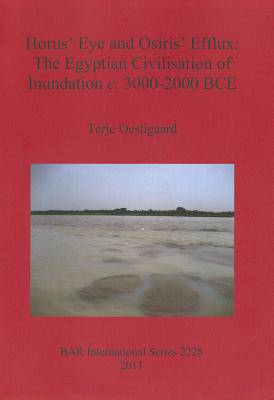
- Afhalen na 1 uur in een winkel met voorraad
- Gratis thuislevering in België vanaf € 30
- Ruim aanbod met 7 miljoen producten
- Afhalen na 1 uur in een winkel met voorraad
- Gratis thuislevering in België vanaf € 30
- Ruim aanbod met 7 miljoen producten
Horus' Eye and Osiris' Efflux
The Egyptian Civilisation of Inundation c. 3000-2000 BCE
Terje OestigaardOmschrijving
Death and the life-giving waters of the Nile were intimately interwoven in ancient Egyptian religion. The principal objective of this study is to develop a synthetic perspective for enhancing the understanding of the religious roles water had in the rise and constitution of the Egyptian civilisation during the Early Dynastic Period and the Old Kingdom. The author employs an archaeological, inter-disciplinary and comparative 'water perspective' in which water not only forms the analytical framework, but also provides empirical data that allow for new questions to be addressed. Thus, the Nile itself is used as the primary point of departure to analyse how, why and when religious changes took place, with a particular emphasis on the development of the Osiris cult. Use is made of contemporary written sources, in particular the Pyramid Texts, but also other mortuary texts as well as flood records. The evolution of the Osiris cult is then analysed in relation to the development of the mortuary monuments; the mastabas in the First and the Second Dynasties and the emergence of the pyramids from the Third Dynasty. Hence, by comparing the different funerary monuments and practices with the emergence of the Osiris cult in relation to climatic changes and fluctuations in the Nile's yearly inundation, Ancient Egyptian religion and the rise of the civilisation is analyzed according to a water perspective. It is noted that the Blue Nile was not blue, but red-brownish during the flood. When the flood started, the White Nile was not white, but green. The author argues that these fundamental characteristics of the Nile water formed the basis for the Osiris mythology. The red floodwaters in particular represented the blood of the slain Osiris.
Specificaties
Betrokkenen
- Auteur(s):
- Uitgeverij:
Inhoud
- Aantal bladzijden:
- 132
- Taal:
- Engels
- Reeks:
- Reeksnummer:
- nr. 2228
Eigenschappen
- Productcode (EAN):
- 9781407307909
- Verschijningsdatum:
- 15/06/2011
- Uitvoering:
- Paperback
- Formaat:
- Trade paperback (VS)
- Afmetingen:
- 211 mm x 295 mm
- Gewicht:
- 399 g

Alleen bij Standaard Boekhandel
Beoordelingen
We publiceren alleen reviews die voldoen aan de voorwaarden voor reviews. Bekijk onze voorwaarden voor reviews.











